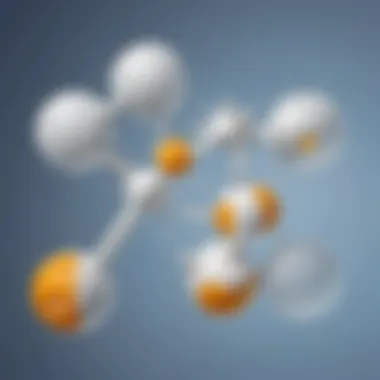Understanding Alka-Seltzer: The Science of Fizzing


Intro
Alka-Seltzer is more than just an antacid; it's a fascinating example of chemistry in action. This product, known for its ability to relieve heartburn and upset stomach, also creates a riveting fizz when dissolved in water. In this article, we will explore the science behind that captivating fizz. We will examine the chemical processes at play, delve into the molecular interactions, and consider how understanding this phenomenon can enhance science education for younger audiences. Let's embark on this journey to uncover the secrets that lie within each effervescent tablet.
Science Fun Facts
Interesting Trivia and Facts
Did you know that the fizzing of Alka-Seltzer is caused by a specific chemical reaction? When the tablet meets water, sodium bicarbonate (baking soda) reacts with citric acid. This reaction produces carbon dioxide gas. This gas is what creates those lively bubbles that everyone finds so entertaining.
- Key Ingredients: Alka-Seltzer contains sodium bicarbonate, citric acid, and aspirin.
- Fizz Duration: The fizz lasts around five minutes and is a visual spectacle for young learners.
- Temperature Effect: Hot water can make the fizzing happen faster than in cold water.
Quirky Science Stories
There's a story of students who made rocket experiments using Alka-Seltzer tablets. By placing them in film canisters with a little water and quickly sealing them, they created small pressure rockets that launched several feet into the air. This simple experiment shows how creativity can lead to exciting scientific exploration.
Amazing Science Records
The fastest fizz recorded was achieved using Alka-Seltzer in warmer water. These quick reactions can lead to impressive visual effects, due to the rapid release of carbon dioxide. Experiments from young children, measuring bubbles produced by different temperatures of water, could lead to fascinating results!
Thought-Provoking Questions
- Why does the fizzing only happen once the tablet is added to water?
- How does changing the temperature of the water affect the reaction?
- Can we explain the concept of gas pressure using Alka-Seltzer as an example?
Discover the Wonders of Science
Exploring Various Scientific Concepts
The fizzing action can introduce children to fundamental concepts of chemistry, like acids and bases. The interaction between sodium bicarbonate and citric acid provides practical examples of how substances react with each other.
Educational Videos and Animations
There are numerous online resources that visually demonstrate the fizzing process. Videos can show real-time reactions, helping kids grasp the concepts more effectively.
Interactive Learning Tools
Many educational platforms offer interactive simulations. These tools allow children to experiment with different solvents, acids, and bases, reinforcing learning through trial and error.
Real-Life Applications of Science
Understanding these reactions can be applied to many real-life scenarios, from cooking to environmental science. Even simple homemade experiments can teach the principles of carbonation and effervescence.
Science Experiment Showcase
Fun and Engaging Experiments
Here’s a simple yet fun experiment you can try at home. Using Alka-Seltzer, you can demonstrate the chemical reaction that produces fizz.
Step-by-Step Instructions
- Gather your materials: Alka-Seltzer tablets, clear glass or cup, water, and a timer.
- Fill the glass with about half a cup of water.
- As you drop the Alka-Seltzer tablet into the water, start the timer and observe the fizzing reaction.
- Take note of how long the fizz lasts.
Materials List
- Alka-Seltzer tablets
- Clear glass or cup
- Water
Safety Tips and Precautions
Make sure to supervise young children during this experiment. Though Alka-Seltzer is safe to use, it’s always good practice to ensure kids do not ingest the tablets before they dissolve.
Remember: Always discuss the results with children after the experiment. It reinforces learning and deepens their understanding!
By understanding Alka-Seltzer's chemistry, children can develop an appreciation for science. This journey into fizzing tablets is not only educational but also inspiring.


Prelims to Alka-Seltzer
Alka-Seltzer plays a notable role in both medicine and chemistry education. Its effervescent characteristics not only provide relief for stomach discomfort, but also serve as an engaging tool to explore basic chemical reactions. Understanding its composition and reactions invites a deeper appreciation of one of the simplest and effective remedies available. The importance of inspecting Alka-Seltzer lies in how it can bridge the gap between practical applications and scientific learning, particularly for young learners.
Overview of Alka-Seltzer
Alka-Seltzer is a well-known over-the-counter antacid. It is commonly used to relieve indigestion, heartburn, and headaches. The product contains several active ingredients that react when mixed with water, producing a fizzy solution. This effervescence is not just for show; it indicates that a chemical reaction is taking place. The combination of sodium bicarbonate and citric acid creates carbon dioxide gas. Recognizing how this simple interaction happens can enhance understanding of acids and bases, making it a perfect subject for educational demonstrations.
History and Development
Alka-Seltzer was first introduced in 1931 by the company Miles Labs. It quickly gained popularity due to its effectiveness in treating common ailments. The product’s development was rooted in the knowledge of chemistry at that time, integrating commonly known compounds in a user-friendly format. Over the years, variations of Alka-Seltzer emerged to target a broader range of symptoms, such as cold and flu relief. This evolution in product design not only met consumer needs, it also showcased how science plays a crucial role in everyday life. Understanding the historical context helps to appreciate how chemical knowledge and practical health solutions can intersect.
Chemical Composition
The topic of chemical composition is crucial in understanding how Alka-Seltzer works. This section will explore the specific elements that make up Alka-Seltzer, describing their individual contributions and the importance of each component to the overall fizzing effect. By knowing the chemical makeup, readers can see the relevance behind the effervescence produced when Alka-Seltzer is mixed with water.
Active Ingredients
Alka-Seltzer primarily consists of three active ingredients: aspirin, sodium bicarbonate, and citric acid. Each of these plays a distinct role in the tablet's function.
- Aspirin is a pain reliever that targets discomfort in the body.
- Sodium bicarbonate neutralizes excess stomach acid, providing relief from indigestion.
- Citric acid contributes to the distinctive fizz that one experiences when the tablet dissolves in water.
The combination of these ingredients creates a unique remedy, showcasing how chemistry can produce beneficial effects for health.
Role of Sodium Bicarbonate
Sodium bicarbonate, commonly known as baking soda, is essential in Alka-Seltzer. Its primary role is to act as a base that counteracts stomach acidity. When you ingest it, it results in a neutralization reaction that reduces discomfort from heartburn or indigestion.
When sodium bicarbonate is mixed with an acid like citric acid, it creates carbon dioxide gas. This is what generates the characteristic fizzing. The reaction also produces water and sodium citrate, which are benign products that aid digestion.
Role of Citric Acid
Citric acid is a key player in the fizzing process. It is a natural acid found mainly in citrus fruits. In Alka-Seltzer, its main function is to react with sodium bicarbonate. When the two substances mix in water, they produce carbon dioxide bubbles, resulting in the observable fizz.
This reaction occurs rapidly, illustrating the dynamics of acid-base interactions in real-time. The effervescence not only signals that the remedy is working but also helps the active ingredients dissolve into the liquid more efficiently. This promotes quicker absorption in the digestive system, heightening the relief from discomfort.
By understanding these components, users can appreciate not just the relief they provide, but also the science behind Alka-Seltzer's efficiency. Each ingredient plays an integrated role in creating the overall effect, making the chemical composition of Alka-Seltzer both fascinating and essential.
The Fizzing Reaction
The fizzing reaction that occurs when Alka-Seltzer dissolves in water is a fascinating demonstration of chemical processes at work. Understanding this reaction is crucial because it illustrates basic principles of chemistry in a vivid and memorable way. The visible bubbles produced during the reaction capture attention, making it an effective tool for educational purposes. This section will explore the underlying processes, the significance of acid-base interactions, and the specific mechanisms that lead to the production of carbon dioxide, which is responsible for the fizzing sensation.
Understanding Chemical Reactions
Chemical reactions lies at the heart of many phenomena we encounter daily. In the case of Alka-Seltzer, when it comes into contact with water, an acid-base reaction occurs. The active ingredients, which include citric acid and sodium bicarbonate, interact in a manner that leads to a change in substances, resulting in the formation of new compounds.
The initial step starts when the tablet is placed in water. The citric acid from the tablet begins to dissolve and mixes with the sodium bicarbonate. As these compounds react, they produce bicarbonate and citric acid ions. This reaction releases energy, often in the form of heat, and leads to the next essential phase – the production of gas.
Acid-Base Reaction Dynamics
The acid-base chemistry of Alka-Seltzer is a perfect example of how these reactions work. Citric acid, being an acid, donates protons (H+ ions) when dissolved in water. Sodium bicarbonate, on the other hand, acts as a base by accepting these protons. This sets off a series of reactions that can be summarized in the following manner:
- Citric acid reacts with sodium bicarbonate.
- Carbonic acid is formed but quickly breaks down into water and carbon dioxide gas (CO2).
This release of carbon dioxide is what creates the distinct fizzing effect. The gases rapidly escape from the solution, leading to the rapid formation of bubbles. Understanding this concept is pivotal as it introduces young learners to the fundamentals of acid-base chemistry, providing relevant real-world applications.
Production of Carbon Dioxide
At the center of the fizzing reaction is the production of carbon dioxide. The importance of CO2 cannot be overstated, as it is the primary reason for the effervescent quality of Alka-Seltzer. When sodium bicarbonate reacts with citric acid, it generates carbon dioxide gas among other products. This occurs essentially through the following reaction equations:
- Citric Acid + Sodium Bicarbonate → Carbonic Acid + Sodium Citrate
- Carbonic Acid → Water + Carbon Dioxide
The rapid release of carbon dioxide bubbles causes a visual display that can mesmerize anyone observing it. In just moments, the tablet transforms into a frothy mixture, demonstrating how effective simple chemical interactions can be when exposed to water. This visual aspect is valuable for demonstrating scientific concepts to children while igniting their curiosity about chemistry and the world around them.
Applications in Education


Understanding the fizzing of Alka-Seltzer can offer significant educational value. It presents a practical example of chemistry principles and promotes hands-on learning for students. Educational applications can captivate young minds, making abstract concepts tangible. When students see immediate results from experiments, their interest in science can flourish. This sparks curiosity and encourages further exploration of scientific ideas.
Experiments for Young Scientists
Performing experiments with Alka-Seltzer is an excellent way for young scientists to engage with fundamental scientific principles. These activities can help children grasp key concepts through direct interaction.
Some simple experiments include using Alka-Seltzer tablets in water to observe fizzing. Children can change variables like temperature or the amount of water. This causes different reaction speeds, allowing them to see science in action.
- Materials Needed:
- Steps:
- Alka-Seltzer tablets
- Water
- Clear cups
- Timer
- Fill a clear cup with a set amount of water.
- Drop in an Alka-Seltzer tablet and start the timer.
- Observe the fizzing and measure how long it lasts.
- Repeat with various temperatures of water to see how it affects the reaction.
Such experiments show children that scientific inquiry often involves observation, measurement, and questioning.
Engaging Science Activities
After conducting basic experiments, educators can introduce additional engaging activities. These sessions can focus on collaborative projects or creative experiments to reinforce learning.
- Group Challenges:
- Science Journals:
- Students can work in teams to design experiments that test different variables, sharing their findings with the class.
- Encourage students to document their observations and experiments in a science journal. This promotes analytical thinking and enhances their understanding of repeatability.
This type of engagement nurtures skills such as teamwork and creativity while reinforcing learned concepts.
Concepts of Acids and Bases
Alka-Seltzer serves as a practical illustration of acids and bases in action. When mixed with water, the citric acid and sodium bicarbonate react and generate carbon dioxide. This chemical reaction is simpler for students to understand.
- Basic Concepts to Cover:
- Definitions of Acids and Bases: Understanding what acids and bases are and their properties.
- Chemical Reactions: How and why reactions occur, illustrated by the fizzing of Alka-Seltzer.
- Real-World Examples: Discussing other products that use similar reactions, like fizzy drinks, can deepen their appreciation for these concepts.
These lessons on acids and bases enhance comprehension and allow learners to recognize the science behind everyday items.
Learning through practical applications not only makes science enjoyable but also creates lasting impressions on young minds.
Comparison with Other Effervescent Tablets
Effervescent tablets hold a unique position in the realm of over-the-counter medications and wellness products. This section will delve into how Alka-Seltzer compares with similar products. Understanding this comparison is crucial for recognizing the specific advantages that Alka-Seltzer offers when it comes to effective relief and fizzing capability.
Similar Products
There are various effervescent tablets available on the market today. Here are a few notable examples:
- Dissolving antacid tablets: These are generally used for treating acidosis and indigestion. They employ similar active ingredients to those found in Alka-Seltzer.
- Vitamin C effervescent tablets: Commonly used as a dietary supplement, these provide a refreshing way to consume essential vitamins.
- Cold and flu remedy tablets: These products often include ingredients designed to alleviate symptoms of colds or flu. They share the fizzing quality that makes them easy to ingest.
In comparing these products, one can see that the fizzing property provides certain benefits. For instance, the fizzy reaction can make swallowing easier for some individuals, enhancing accessibility to medication, especially in children and those who struggle with swallowing pills.
Differences in Composition and Reaction
Alka-Seltzer distinguishes itself from other effervescent tablets largely through its chemical composition and the specific reactions it facilitates. Here’s how:
- Active Ingredients: Alka-Seltzer contains both sodium bicarbonate and citric acid, creating a unique formula designed specifically for relieving heartburn, acid indigestion, and upset stomach. Other effervescent tablets may have varying active components tailored for their targeted effect.
- Reaction Type: The primary reaction in Alka-Seltzer is an acid-base reaction, resulting in carbon dioxide production. This reaction is distinct from the processes involved in other medications that might use different mechanisms or chemicals.
The diversity in composition and reaction contributes to the overall effectiveness and user experience. While some alternatives may cause varying levels of fizz, they might not offer the same speed of action or relief that Alka-Seltzer provides.
Effervescent tablets can often bring an interesting twist to medication delivery, capturing attention through their fizzing behavior, thereby enhancing the consuming experience.
In summary, while Alka-Seltzer is part of a broader category of effervescent tablets, its specific formulation and reaction set it apart, making it an essential choice for certain health needs.


Understanding Fizzing in Everyday Life
Fizzing is a common phenomenon observed in various situations, from a glass of soda to a science experiment. Understanding fizzing can enhance our understanding of everyday products, making it relevant not just for scientific study but also for practical applications. Learning about fizzing invites inquiry and exploration, encouraging curiosity in both children and adults. This section delves into two essential aspects: the science of carbonation and the natural occurrences of fizzing, shedding light on their implications in our daily lives.
The Science of Carbonation
Carbonation refers to the process of dissolving carbon dioxide gas in a liquid, creating bubbles that rise to the surface. This principle plays a vital role in many beverages, such as sodas and sparkling waters. The science behind carbonation involves several steps:
- Dissolution: At high pressure, carbon dioxide gas is forced into the liquid. This process is known as carbonation.
- Release: Once the pressure is released (when opening a bottle or can), the gas escapes, forming bubbles.
- Fizz: The rapid release of gas is what gives drinks their characteristic fizz.
Children can witness this phenomenon in a straightforward manner by adding effervescent tablets, like Alka-Seltzer, to water. They see immediate fizzing, which can lead to questions about why it happens and how these reactions relate to carbonation in other drinks. Understanding carbonation is essential not only for science education but also for making informed choices about what we consume.
Natural Occurrences of Fizzing
Fizzing is not limited to manufactured products. It occurs naturally as well. Here are a few examples:
- Volcanic Activity: When magma containing dissolved gases rises to the surface, gas bubbles can form rapidly, resulting in fizzing and sometimes explosions.
- Fermentation: In the production of beer or bread, yeast ferments sugars, releasing carbon dioxide as a byproduct. This gas causes the fizzing effect in beer and helps bread rise.
- Natural Mineral Springs: Some mineral springs naturally produce carbonated water due to dissolved gases.
Educators can use these examples to explain the role of fizzing in nature and its importance in various environmental processes. Encouraging children to observe these phenomena fosters an appreciation for the intricacies of science in the environment around them.
"Fizzing is not just a fun reaction; it reveals the underlying chemical processes that shape our world."
Understanding fizzing involves more than observing the bubbles; it opens a dialogue about chemistry and its practical implications, enriching both education and everyday experiences.
Safety Considerations
Safety is a crucial aspect when discussing Alka-Seltzer and its usage. Understanding safety considerations helps ensure safe and effective use of this common over-the-counter remedy. Parents and caregivers must be aware of proper usage guidelines to prevent any adverse effects on children or sensitive individuals. Promoting a safe environment for experiments or activities involving Alka-Seltzer also plays a role in fostering a healthy attitude towards science and exploration.
Proper Usage Guidelines
Using Alka-Seltzer appropriately is vital for achieving the desired results without risks. Here are the main points to consider:
- Dosage: Always follow the recommended dosage on the packaging. For children, this may differ from adult dosages. Consult a healthcare professional if unsure.
- Mixing with Foods or Drinks: Do not mix Alka-Seltzer with any drinks that are carbonated or contain alcohol. This can amplify the carbonation effect and lead to unexpected reactions.
- Not for All Conditions: Alka-Seltzer is not suitable for every ailment. Ensure that its usage aligns with the symptoms. For example, it is primarily used for heartburn or upset stomach.
- Storage: Keep Alka-Seltzer in a cool, dry place. Moisture can lead to a chemical reaction before you intend to use it.
Proper usage of Alka-Seltzer can minimize risks and enhance its benefits, allowing users to experience the fizzing action as intended.
Understanding Allergens and Sensitivities
Awareness of potential allergens is crucial when using Alka-Seltzer. The active ingredients may not be suitable for everyone, especially those with certain food sensitivities or allergic reactions. Here’s what you might consider:
- Aspartame: Present in some formulations, this artificial sweetener can trigger sensitivities in certain individuals, especially those with phenylketonuria (PKU).
- Sodium: This ingredient may pose a risk for people on restricted sodium diets.
- Citrus Sensitivities: Those sensitive to citrus should be cautious due to the citric acid in Alka-Seltzer.
Recognizing and understanding these sensitivities is vital for ensuring that the remedy does not cause unforeseen health issues. Always read labels carefully and consult a doctor if there are questions regarding allergies.
Finale
In the exploration of Alka-Seltzer and its fizzing phenomenon, we uncover multiple layers of scientific understanding. This section emphasizes the significance of comprehending the chemical reactions that produce its characteristic effervescence.
The fizzing reaction involves a simple yet fascinating interaction between acids and bases. By recognizing how sodium bicarbonate and citric acid collaborate to create carbon dioxide, we can appreciate the elegance of chemistry in everyday life. This insight is not solely academic; it holds real-world applications, particularly in education.
Key benefits of understanding this reaction include:
- Enhanced Learning: Young learners can grasp fundamental concepts of chemistry through tangible examples.
- Curiosity Encouragement: Exploring such reactions can inspire an ongoing interest in scientific inquiry.
- Practical Applications: Recognizing how compounds work together fosters responsibility in using common medications safely.
Moreover, considerations around safety and usage guidelines reinforce the need for an informed approach when using products like Alka-Seltzer. Equipping children with this knowledge can empower them to make informed decisions about their health and science experiments.
"Understanding the science behind our daily interactions with products can enhance not only our knowledge but also our safety."
In summary, this conclusion ties together the various discussions around Alka-Seltzer and its scientific foundations while highlighting the broader implications of engaging students with practical scientific experiences.
Summary of Key Points
- Alka-Seltzer’s fizz results from an acid-base reaction between sodium bicarbonate and citric acid.
- The production of carbon dioxide gas is the catalyst for the fizzing effect.
- Hands-on science activities can utilize this reaction to teach essential chemical concepts.
- Safety considerations are crucial when educating children on using effervescent tablets.
Future Explorations
Engagement in the science behind fizzing does not end here. Future explorations could include:
- Investigating other daily products that produce fizz, such as soda or sparkling water.
- Conducting experiments to compare the fizzing actions of various effervescent tablets.
- Designing classroom activities that demonstrate principles of gas release using safe, household items.
- Exploring the importance of acids and bases in other contexts, such as food science or environmental studies.
By continuing to delve into these subjects, young learners and educators collectively nurture a robust understanding of chemistry that can lead to advanced studies and lifelong interests.







